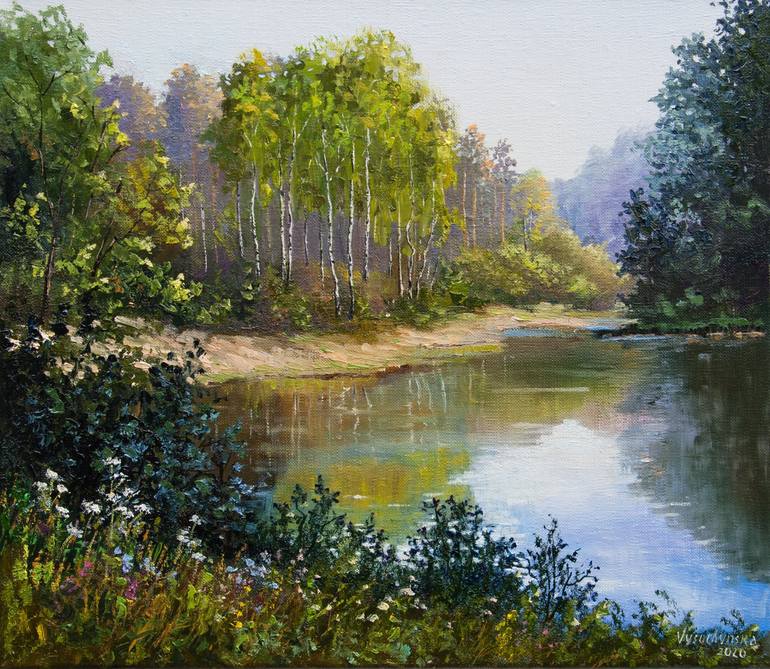Checking out All Regarding Oil Paintings: A Guide to Comprehending Their Elegance and Worth
Oil paints have actually astounded target markets for centuries, supplying a glimpse into the artistic mastery of various ages. Their rich history is linked with cutting-edge methods and profound emotional expression. Understanding the products and approaches behind these art work can enhance appreciation. Additionally, the marketplace for oil paints provides opportunities for investors and collectors alike. As one discovers this interesting world, the question arises: what makes an oil painting truly valuable?
The Background of Oil Painting: A Trip With Time
Oil painting has origins that date back to ancient times, it truly grew throughout the Renaissance, when musicians found its versatility and abundant color possibility. Early examples can be mapped to the 7th century, with methods evolving notably throughout cultures. The tool ended up being noticeable in Northern Europe in the 15th century, especially via the works of musicians like Jan van Eyck, who originated its use for thorough realism and vibrant colors. This period noted a departure from tempera paints, enabling greater depth and structure. As oil paint spread, it affected numerous artists, leading to work of arts by renowned figures such as Leonardo da Vinci and Rembrandt. The tool's tradition continues, forming the art world well right into modern-day times.
Recognizing Oil Paints: Products and Techniques
As artists check out the globe of oil paints, they encounter a diverse variety of products and methods that specify this tool. The key parts of oil paint consist of pigments, which provide color, and drying oils, such as linseed, that bind the pigments and help with application. Different additives can customize the paint's appearance and drying out time, enhancing adaptability. Strategies like glazing, where clear layers are built up, and impasto, which involves using thick paint, permit various visual impacts. In addition, the use of brushes, palette blades, and also fingers can develop unique structures and coatings. Comprehending these strategies and products makes it possible for musicians to fully share their creativity and achieve the preferred influence in their art work.
The Duty of Shade in Oil Paints
Shade plays a pivotal function in oil paints, influencing both visual allure and emotional resonance. Recognizing color theory basics, consisting of the partnerships in between tones, can improve an artist's capacity to communicate mood and ambience. In addition, grasping color mixing techniques permits for higher depth and splendor in a painting's scheme.

Shade Concept Essential
Recognizing shade concept is necessary for musicians dealing with oil paints, as it forms the foundation for developing visually interesting and unified structures. Color theory incorporates the research of exactly how colors interact, the color wheel, and the partnerships between key, additional, and tertiary colors. Musicians utilize corresponding colors to improve contrasts and create focal points, while similar shades advertise unity and cohesiveness within an item. Furthermore, the ideas of cozy and great shades affect the understanding of deepness and area in a painting. Grasping these principles enables musicians to manipulate color properly, leading the viewer's eye and communicating their designated message. Mastery of color theory inevitably enhances an artist's ability to communicate feelings and ideas through their work.
Psychological Influence of Color
The emotional influence of shade in oil paintings plays a crucial function in just how viewers attach and regard with artwork. Colors evoke details sensations and moods, influencing the visitor's mood. For circumstances, warm tones like reds and oranges can develop a sense of heat and energy, while great tones such as blues and greens usually stimulate peace or self-questioning. Artists strategically select color combinations to boost narrative elements, directing the audience's emotional journey. The saturation and comparison of shades better intensify these results, attracting focus and developing emphasis. Eventually, the interaction of shades in oil paints not only enhances their aesthetic appeal but also functions as a powerful medium for emotional expression, enhancing the customer's experience and analysis.
Color Mixing Techniques
While numerous elements of oil painting add to the general composition, understanding color blending techniques is vital for attaining desired results and deepness. Shade mixing can be approached via numerous approaches, consisting of the subtractive and additive procedures. Additive blending entails incorporating shades of light, while subtractive blending relies upon pigments, where colors blend to create new tones. Musicians commonly use a restricted palette to develop harmonious jobs, recognizing the relationships between key, secondary, and tertiary shades. Strategies such as glazing and scumbling better improve depth and luminosity. By masterfully blending colors, a musician can evoke feelings, create focal factors, and accomplish a sense of realistic look, inevitably raising the painting's aesthetic and psychological influence.
Famous Oil Painters and Their Iconic Works

Famous for their proficiency of shade and strategy, oil painters have actually developed several of the most popular art work in background. Popular artists like Vincent van Gogh captivated audiences with his emotive brushwork in "Starry Night," while Claude Monet's "Impression, Dawn" laid the groundwork for Impressionism. Leonardo da Vinci's "Mona Lisa" stays an enduring sign of creative brilliant, showcasing his ability in recording human expression. Rembrandt's "The Evening Watch" shows his ingenious usage of light and shadow. Other significant numbers consist of Pablo Picasso, that transformed modern art with his strong testing in works like "Les Demoiselles d'Avignon," and Georgia O'Keeffe, whose dynamic depictions of landscapes and flowers assisted define American modernism. Each artist's one-of-a-kind style contributed substantially to the oil paint landscape.
Just how to Evaluate the Quality of an Oil Painting
Evaluating the quality of an oil painting entails a cautious assessment of workmanship methods, as well as an evaluation of color and composition. Observing brushwork, layering, and the application of paint can disclose the musician's skill degree. Additionally, the interaction of shades and the general plan of components add considerably to the paint's visual worth.
Examining Workmanship Methods
A careful evaluation of craftsmanship methods is necessary for establishing the top quality of an oil paint. Evaluators should first check out the application of paint; thick, distinctive brushstrokes might suggest a knowledgeable hand, while extremely consistent applications might suggest a lack of deepness. oil paintings for sale. The layering strategy is likewise important; the presence of lusters and differed density can improve luminosity and complexity. In addition, the top quality of the products used, such as the canvas and pigments, plays a significant role in toughness and overall aesthetic. Focus to detail in components like edges and shifts in between colors mirrors the musician's dedication to their craft. Ultimately, these strategies add to the painting's psychological influence and market worth, acting as indicators of the artist's ability and intent
Analyzing Color and Structure
While reviewing the quality of an oil painting, one need to concentrate on the interaction of shade and composition, as these aspects are essential to the art work's total influence. Color choices can establish and evoke feelings mood; for that reason, the artist's combination ought to be examined for consistency and contrast. A well-balanced composition directs the viewer's eye and creates a sense of unity. Artists typically utilize methods like the policy of thirds or leading lines to enhance visual interest. Additionally, making use of light and darkness can include depth, enhancing the three-dimensionality of the painting. Inevitably, a successful oil paint weds shade and structure, engaging the audience and inviting a deeper appreciation of the musician's vision and strategy.
Taking care of and Preserving Oil Paintings
Appropriate treatment and conservation of oil paints is crucial for maintaining their honesty and long life. To protect these artworks, it is essential to present them far from direct sunlight, which can trigger fading and discoloration. Keeping a secure setting with controlled temperature and humidity more help in protecting against damages. Cleansing must be done carefully utilizing a soft, completely dry fabric, preventing any harsh chemicals that can hurt the paint or varnish. Routine inspections for signs of wear and tear, such as flaking or cracking, are suggested. When storing or moving oil paintings, correct cushioning and framing are needed to avoid physical injury. Eventually, attentive care adds to the aesthetic appeal and value of oil paints in time.
The Marketplace for Oil Paintings: Accumulating and Investing
Comprehending the market characteristics for oil paintings is important for capitalists and collection agencies alike. The check here worth of these artworks is influenced by different elements, including the musician's credibility, historical value, and present patterns. Collectors usually seek items that resonate directly while thinking about potential admiration in worth. Galleries and public auctions function as key places for trading, with costs varying based upon need and rarity. Buying oil paintings requires study into the marketplace, in addition to an understanding of authenticity and provenance. Furthermore, arising musicians might supply possibilities for significant returns, while established names can regulate high prices. Generally, a critical approach to collecting can yield both aesthetic pleasure and financial rewards.

Regularly Asked Inquiries
What Are the Environmental Influences of Oil Painting Products?
The environmental influences of oil paint materials include the release of unstable natural substances (VOCs), damaging waste generation, and resource removal for pigments. These factors add to contamination and environmental deterioration, elevating issues among eco aware musicians and consumers.
Exactly How Do Various Canvases Influence Oil Paint Outcomes?
Various canvases influence oil painting results significantly. Absorbency, surface, and texture high quality can change paint application, drying times, and color vibrancy. Artists typically select particular canvases to accomplish desired effects and enhance their imaginative expression.
Can Oil Paintings Be Recovered if Harmed?
If damaged, Oil paintings can certainly be brought back. Professional conservators utilize numerous strategies to repair splits, clean surfaces, and address discoloration, guaranteeing that the artwork retains its initial appeal and worth for future generations.
What Are the Indications of an Original Oil Paint?
The indicators of an original oil painting include noticeable brush strokes, appearance variants, and an irregular canvas weave (oil paintings for sale). Additionally, credibility may be verified through provenance, signatures, and the presence of a varnish layer one-of-a-kind to oil tools
How Has Modern Technology Influenced Modern Oil Paint Techniques?
Technology has actually considerably affected contemporary oil painting methods by introducing electronic devices for preparation, boosted materials for texture and longevity, and online systems for sharing and selling art, therefore increasing musicians' innovative possibilities and audience reach. Oil painting has origins that date back to old times, it genuinely grew throughout the Renaissance, when musicians found its flexibility and rich shade possibility. The psychological effect of color in oil paintings plays a vital duty in exactly how audiences connect and regard with art work. While numerous aspects of oil paint add to the overall make-up, grasping color mixing strategies is vital for achieving wanted impacts and depth. Reviewing the high quality of an oil painting entails a mindful evaluation of craftsmanship strategies, as well as an analysis of shade and structure. While evaluating the high quality of an oil painting, one need to focus on the interaction of color and make-up, as these elements are basic to the artwork's total influence.